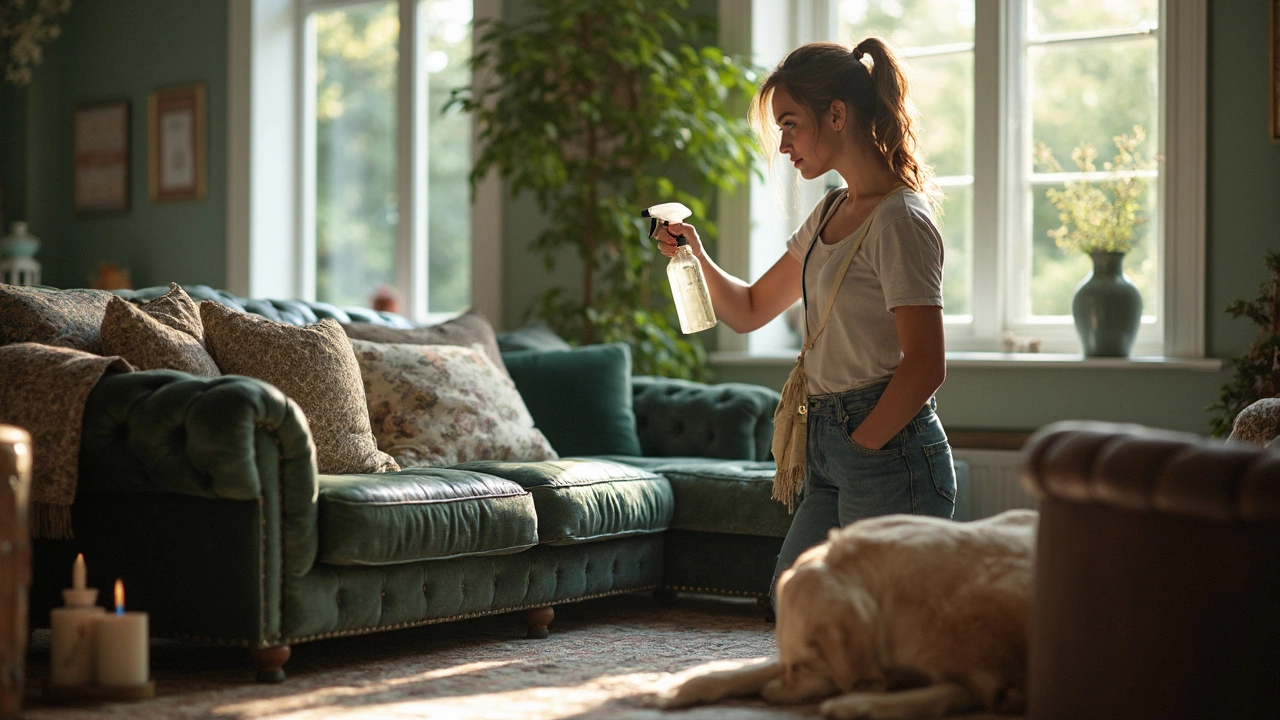You know that moment you flop onto your favorite chair, only to catch a whiff of something funky? Yeah, you’re not alone. Upholstery traps smells like a sponge, whether it’s from spilled coffee, sweaty workout clothes, or – in my case – a dog who thinks every cushion is a nap zone.
Most people rush to mask odors with sprays, but those just hide the stink for a while. If the source is still trapped in the fabric or padding, the smell comes back with a vengeance. The trick is finding a real odor eliminator that neutralizes, not just perfumes. Trust me, covering up pet funk with lavender only makes your sofa smell like lavender-flavored wet dog.
Here’s what matters: how deep the odor is, what caused it, and how well your solution breaks it down—not all smells need the same fix. Some odors need enzymes, others need oxidizers, and sometimes, plain old sun and air work wonders. It’s not magic, but there are definitely tricks the pros use that you can too. Ready to actually solve those upholstery odors for good?
- Why Does Upholstery Hold Odors?
- Quick Fixes and Mistakes to Avoid
- Tried-and-True Odor Eliminator Products
- DIY Solutions That Actually Work
- Extra Tips for Keeping It Fresh
Why Does Upholstery Hold Odors?
It’s wild how easily upholstery hangs onto smells. Fabric furniture is like a magnet for anything stinky – sweat, food, pets, you name it. The big reason? Upholstery is full of tiny holes, fibers, and padding underneath. All that material sucks up moisture and airborne particles. Once inside, smells dig in deep and don’t want to come out.
Some materials trap stink more than others, too. Cotton and wool grab odors more easily than faux leather or vinyl. And the more layers your couch or car seat has, the harder it is to get smells out. Humans shed about 500 million skin cells a day – and they end up in your upholstery along with crumbs, fur, and spilled drinks. It’s a buffet for odor-causing bacteria.
Here’s a look at the usual suspects that get trapped in upholstery:
- Pet accidents (pee, drool, fur oils)
- Food drops and drink spills
- Cigarette smoke or vaping residue
- Sweat and body odors
- Musty air (especially when rooms are humid)
Bacteria and mold thrive on moisture and organic material. When they break things down, they release gases. That’s the nasty smell hitting your nose. If you just spray the outside, the inside can keep smelling for weeks.
Check out this quick table that shows how long different odors can linger in fabric if you don’t use a legit odor eliminator:
| Odor Source | Lingering Time (without proper cleaning) |
|---|---|
| Pet urine | 1-6 months |
| Cigarette smoke | 6+ months |
| Food spills | Weeks to months |
| Musty odors | Months or until humidity drops |
The odor eliminator you pick has to break through all those stubborn layers. If you just let smells sit, they get tougher to remove over time. That’s why fast action makes your life easier.
Quick Fixes and Mistakes to Avoid
When you smell something off on your upholstery, your first instinct might be to grab an air freshener or douse the area with a random cleaner. Don’t. Sprays that just make the room smell nicer usually do nothing for what’s still buried in the fibers. It’s like using mouthwash instead of actually brushing your teeth—looks fine at first, but the problem’s just hiding.
Here’s what a lot of folks try in a pinch—and where things go sideways:
- Odor eliminator sprays (the masking kind): They cover things up, but the stink will seep back out once their scent fades.
- Baking soda dump and vacuum: While not bad in a pinch, just sprinkling and vacuuming rarely gets rid of deep smells on thicker cushions. It’s better than nothing, but not a miracle.
- Using too much water or cleaner: Drenching fabric can push odors deeper and even lead to mold. That’s how small mishaps turn into big problems.
- Mixing products: Ever see foaming madness or weird stains because someone mixed two different cleaners? Chemical reactions can mess up your fabric or irritate your skin.
If you need to act fast (like when surprise guests are about to show up), here’s a quick step-by-step that’s actually worth your time:
- Spot-check the smell source. If you see a stain, blot (don’t rub) with a clean cloth.
- Lightly sprinkle baking soda, let it sit 15-30 minutes, then vacuum. This grabs minor scents off the surface.
- Open windows and aim a fan at the area. Good airflow really helps for smoke, food, or pet odors.
Check out this table for what works fast vs. what you should skip:
| Quick Fix Method | Works? | Notes |
|---|---|---|
| Air freshener spray | No | Just masks, comes back fast |
| Baking soda & vacuum | Sort of | Helps with light surface smells only |
| Open windows/fan | Yes | Best for smoke or cooking odors |
| Dousing with water | No | Can cause mold, pushes odor deeper |
Bottom line: If you need to freshen up in a hurry, keep it simple. Don’t turn a tiny smell into a weeks-long battle by panicking with random cleaning experiments. Save the deep cleaning for after the guests leave—or when you’re ready to really tackle the problem for good.

DIY Solutions That Actually Work
If you don’t want to buy expensive sprays, good news—there are easy DIY fixes for funky upholstery. Seriously, most of what you need is probably already in your kitchen. But not every home remedy you see online is worth trying. Let’s talk about what actually knocks out strong odors on couches, car seats, or chairs.
- Baking Soda Boost: Baking soda is king for neutralizing smells—not just covering them. Just sprinkle it over the smelly area, let it sit for at least 30 minutes (overnight is better for tough odors), then vacuum it up. Works wonders for pet and food smells. Don’t use it on silk or anything water-sensitive, though.
- White Vinegar Spray: Mix equal parts white vinegar and water in a spray bottle. Lightly spritz the surface (don’t soak). This breaks down odor particles, like dog or smoke stink. Let it dry, and the vinegar smell vanishes after a few hours. Always do a patch test first, especially on colored fabrics.
- Lemon Power: Got a light, lingering smell? Squeeze half a lemon into a cup of warm water, dip a cloth in, and dab (don’t rub) the spot. Citric acid kills bacteria and leaves things fresh. Again, test on a small hidden spot first.
- Enzyme Cleaner: If the smell is from vomit, urine, or anything biological (thanks Charlie!), you need enzymes. Mix 2 cups warm water with 1 tablespoon clear detergent and 1 tablespoon white vinegar, blot it on, then rinse with a clean cloth. Some folks buy pet enzyme cleaners for this, too—and they work.
Here’s a simple table comparing DIY ingredient effectiveness on common smells:
| Odor Type | Baking Soda | Vinegar | Lemon | Enzyme Mix |
|---|---|---|---|---|
| Pet Odor | Good | Okay | Fair | Excellent |
| Food Spills | Excellent | Good | Fair | Good |
| Smoke | Good | Excellent | Poor | Fair |
| Mildew | Okay | Good | Okay | Fair |
No matter which DIY route you take, always start by vacuuming first. This removes any loose dirt or hair that could trap smells—especially important for upholstery cleaning. And if you’re ever in doubt, do a tiny test patch so you don’t ruin your furniture. These fixes don’t just mask the smell—they actually go after what’s causing it, saving your space (and nose) in the long run.
Extra Tips for Keeping It Fresh
Once you’ve tackled the source of the stink, keeping upholstery fresh is actually way less work than you think. Most people only clean when something smells, but quick routines can stop odors from building up in the first place. Here’s what works—straight from houses with pets, kids, and actual life happening.
- Vacuum regularly: Even if you don’t see crumbs or hair, there’s dust and invisible stuff collecting all the time. A weekly vacuum (go slow and use the upholstery attachment) sucks up the stuff that eventually causes odors.
- Let fabrics breathe: Open windows when you can. Fresh air does wonders for funky sofas—just an hour helps waft out lingering smells.
- Rotate cushions and pillows: This wears fabrics evenly and prevents any one spot from getting extra sweaty or damp (I learned this the hard way with Charlie hogging the same armrest every day).
- Wash removable covers: If your couch or chair has zip-off covers, toss them in the wash every few months. Use fragrance-free detergent so nothing clings in the fibers.
- Spot clean fast: The longer a spill or accident sits, the more likely it is to turn into a long-term smell. Blot up messes and hit them with a odor eliminator spray right away.
Air purifiers can actually make a difference, especially if you have allergies or you’re super sensitive to pet odors. Studies have shown HEPA filter purifiers help reduce not just dust but also smell-causing particles floating around. If you have a pet like Charlie, investing in a decent air purifier makes cleaning days way less of a headache. Check out some quick facts:
| Tip | Frequency | Why It Works |
|---|---|---|
| Vacuum Upholstery | Weekly | Prevents buildup of odor-causing debris |
| Wash Covers | Once every 2-3 months | Removes embedded smells and freshens fabric |
| Open Windows | Whenever possible | Flushes out trapped odors and moisture |
If you cook a lot or smoke indoors, odors can stick to fabric without you realizing. Mixing a half-and-half solution of white vinegar and water in a spray bottle and lightly misting (test first on an unseen spot!) can nix those invisible buildups. Always let things dry with plenty of air flow.
It’s all about small habits. If you stick with the basics, your couch and chairs won’t surprise you—or your guests—with unexpected smells.
